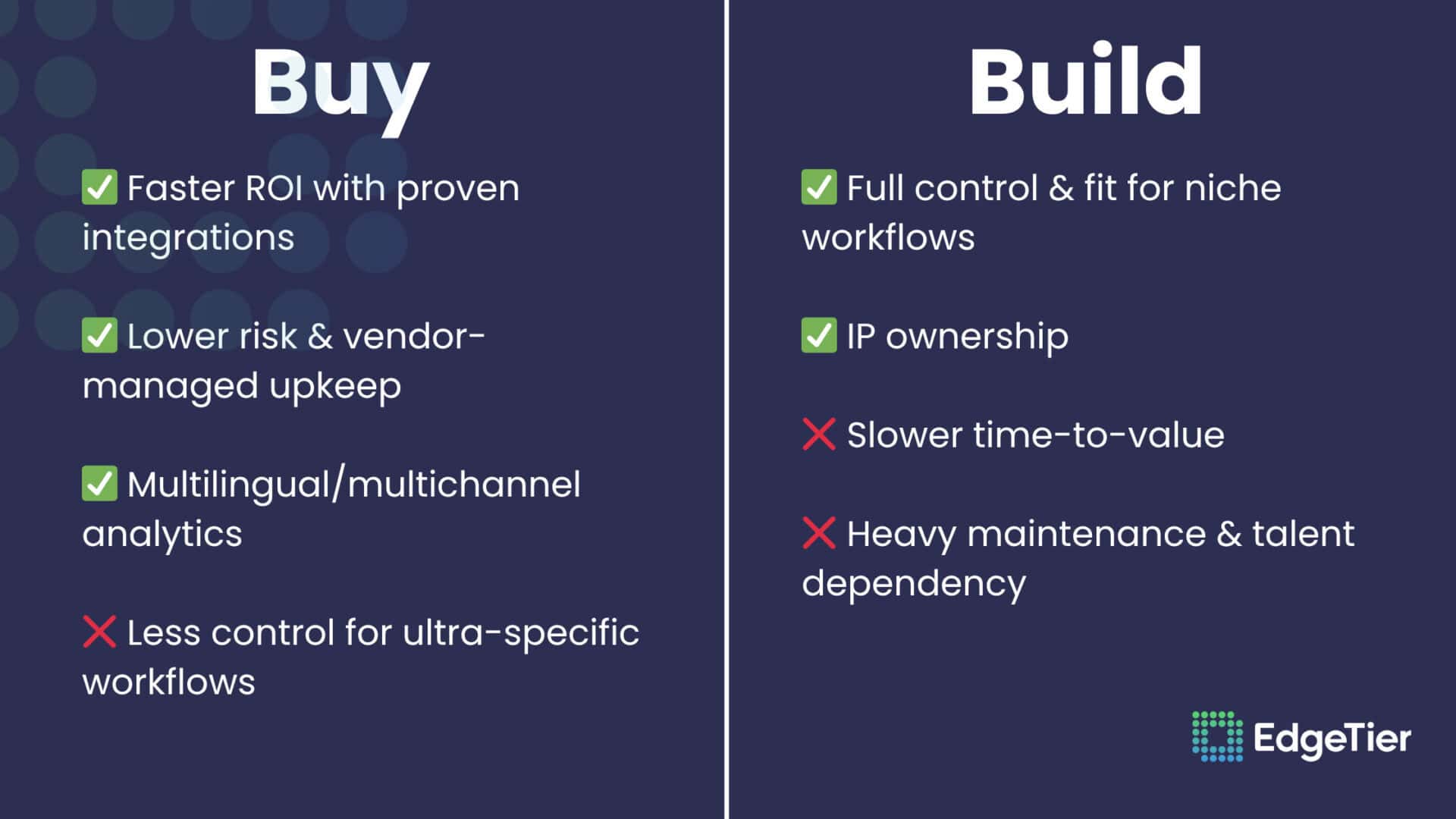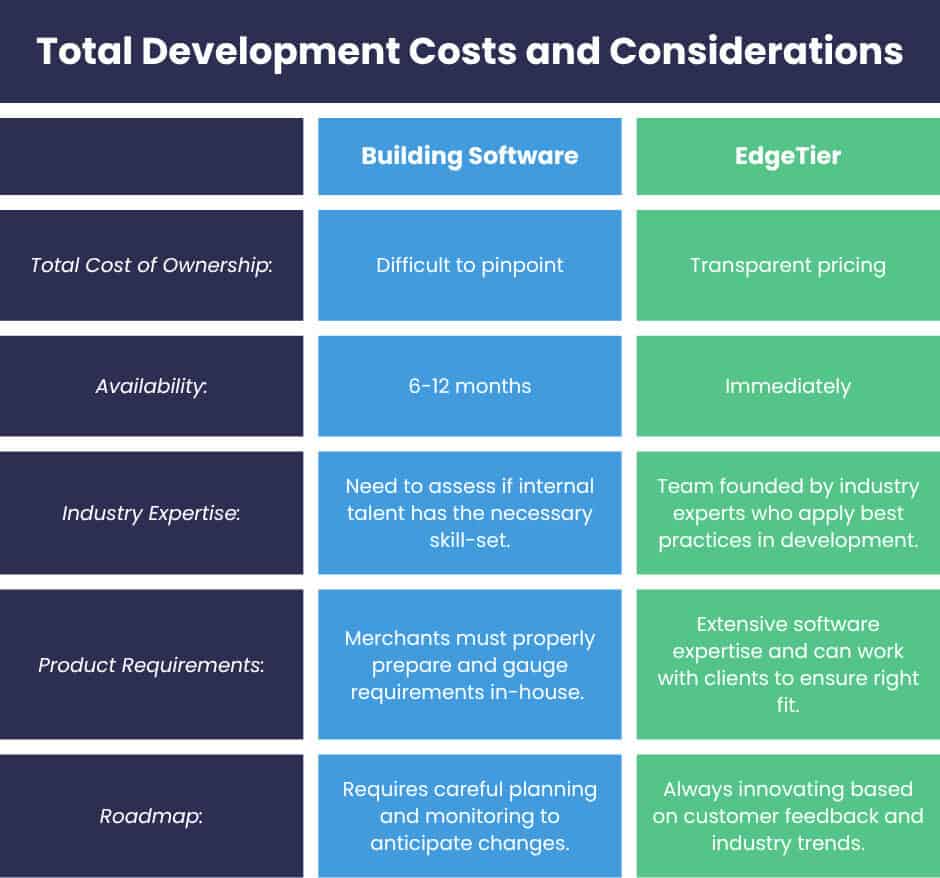Customer Support Data Maturity: The 4 Levels That Define CX Success
This article originally appeared on Edge Signals – Bart Lehane’s LinkedIn newsletter on customer experience, analytics, and AI. Follow for
Summary At a certain point in every CX leader’s journey towards optimisation, you are faced with a decision: should you build your own software solution to fulfill your customer analysis needs, or buy an existing product from a leading provider? When it comes to customer interaction analytic tools like EdgeTier, the build vs. buy conundrum…

At a certain point in every CX leader’s journey towards optimisation, you are faced with a decision: should you build your own software solution to fulfill your customer analysis needs, or buy an existing product from a leading provider? When it comes to customer interaction analytic tools like EdgeTier, the build vs. buy conundrum is not really a question of engineering vanity or vendor loyalty. It’s about three core considerations:
One thing has become abundantly clear, however – adoption of something is non-negotiable in this space. According to McKinsey, 65% of companies already report using some form of AI software, and the customer service industry is one of the most active domains. The decision to build or buy EdgeTier ultimately depends on your specific needs and this guide, informed by our experience working with hundreds of customers on this very decision, will help you navigate with confidence.
| Factors influencing the decision to buy | Factors influencing the decision to build |
| Limited in-house experience building/operating customer-service AI at production quality. The company cannot fund and retain the cross-functional team needed to maintain and evolve a CS-AI platform for years (Eng/ML/Data/Product/Enablement). The roadmap demands fast time-to-value on metrics like contact deflection, AHT, QA, and anomaly detection. The stack requires broad, proven integrations (Zendesk, Salesforce, Intercom, voice/email/social) and multilingual coverage. The company prefers predictable OpEx with clear data-export paths to keep optionality (warehouse/BI), and wants vendor-managed security/compliance updates. Engineering/ML turnover risk is high, or leadership wants to shift delivery/maintenance risk to a specialist vendor. The ability to essentially buy the roadmap of advances and development. | Meeting company needs via vendor configuration would be highly complex (unique workflows, niche compliance), making custom development more practical. The company requires full control over data residency, model behaviour, audit logs, and release cadence. The company has a stable, well-resourced ML/Platform team with the skills (and time) to build, evaluate, and maintain CS-AI systems long term. Proprietary conversational data is a differentiator, and leadership wants to own retrievers, evaluation sets, and IP. There are strict hosting constraints or ultra-low-latency requirements that standard platforms can’t meet. The company is committed to remaining at the leading edge of advances in AI and analytics, and building tech to take advantage of this. |
Think of this table as an initial map, not a verdict: it tells you where your advantage likely lives – speed and operating leverage on the buy side; control and bespoke fit on the build side. If your calendar says “this quarter,” you’re probably in EdgeTier-country; if sovereignty, unusual workflows, and data IP are the headline, building may feel inevitable. Still undecided? Well, the adventure continues!
“No matter what new tools come in the future, the purpose of business will always remain the same: to solve important problems for customers.” – Harvard Business Review

Flexibility
Support
Scope
Speed
Integrations
With your bearings set, the next step is to be honest about consequences. The tables below translate those signals into day-to-day realities of obtaining or creating some form of CX analytics – what you gain and what you take on – across speed to value, governance load, maintainability, and control. Use them to circle the two or three items that would most shift next quarter’s outcomes (QA issues, improving CSAT scores, greater visibility, etc.); that’s your practical bias to build or invest in a tool like EdgeTier.
| Pros | Cons |
| Deep fit for unusual workflows and compliance nuance; you can encode policy exactly. | Slower time-to-confidence; value depends on landing data quality, eval, and integrations. |
| Full control of data residency, model behaviour, features, latency budgets, and release cadence. | Permanent maintenance burden (evaluation, drift, guardrails, incident playbooks). |
| IP compounding from proprietary datasets, retrievers, and evaluation sets. | Talent dependency; losing key engineers stalls roadmap and raises risk. |
| Flexible agent UX – embed internal tools, bespoke QA/rubrics, domain tone tightly. | Opportunity cost – pulls engineering from core product/roadmap. |
| Potential long-run TCO leverage at very high, stable volumes. | Pace risk – harder to keep up with rapid model/channel/policy changes. |
| Pros | Cons |
| Fast time-to-value with proven connectors and real-time analytics/alerts that have been honed over time. | Possible fit gaps in ultra-specific workflows; opinionated UX/flows to work around. |
| Lower operational risk – we handle evaluation, safety updates, change logs. | Vendor dependency – roadmap influence and long-term pricing need managing. |
| Multilingual & multichannel coverage out of the box (chat/email/voice/social). | Less low-level control of models/latency and some runtime details. |
| Predictable OpEx and easier scaling across teams/regions. | Data residency/sovereignty limits depend on vendor regions – must be verified. |
| Data portability (exports/APIs) to keep optionality with your warehouse/BI. | Adoption risk if change management is weak – tools can be configured but unused. |
| Credibility: measurable impact (AHT, FCR, CSAT, etc.) supports your business case and career narrative. | Works best as the hub: Light governance is needed to avoid tool sprawl and maximize value. |
Now, not every row in those tables carries the same weight for your business when it comes to customer service. What matters is how these trade-offs intersect with your urgency, workflow uniqueness, talent bandwidth, regulatory posture, and integration surface.
Next, we’ll examine the total cost of build vs buy to help you move the needle from opinions to an evidence-backed choice.

If your priority is to solve customer problems faster – not just report on them – EdgeTier is the “buy” that gets you there quickly and credibly. It brings your eyes and ears to every interaction across channels and languages, then highlights why customers are contacting you so you can fix issues at the root, not just handle them.
However, if sovereignty is truly your north star and you are sufficiently resourced for a platform (both in terms of time and finance), build is definitely the way to go for you – but hold it to the same standard that EdgeTier does!
If you want to spot issues sooner and fix them faster, let’s walk you through a live view on your conversations.
This article originally appeared on Edge Signals – Bart Lehane’s LinkedIn newsletter on customer experience, analytics, and AI. Follow for
Generative AI chatbots are transforming customer service – but also creating a new kind of risk. When AI assistants hallucinate,
Following on from our recent update to the Home screen, which introduced a new way to surface the most pressing
"The average response time for post-booking type emails is about five hours. Previously, it was over 24 hours."
"We thought at the time that we were putting the customer at the fore. We thought we were doing things right. But in hindsight, we really weren’t because we had no real-time insights whatsoever into customer issues."
"You’ve got an issue, but you don’t know how many people are affected. You don’t know the scale. You don’t even know if it’s real."



Let us help your company go from reactive to proactive customer support.
Unlock AI Insights